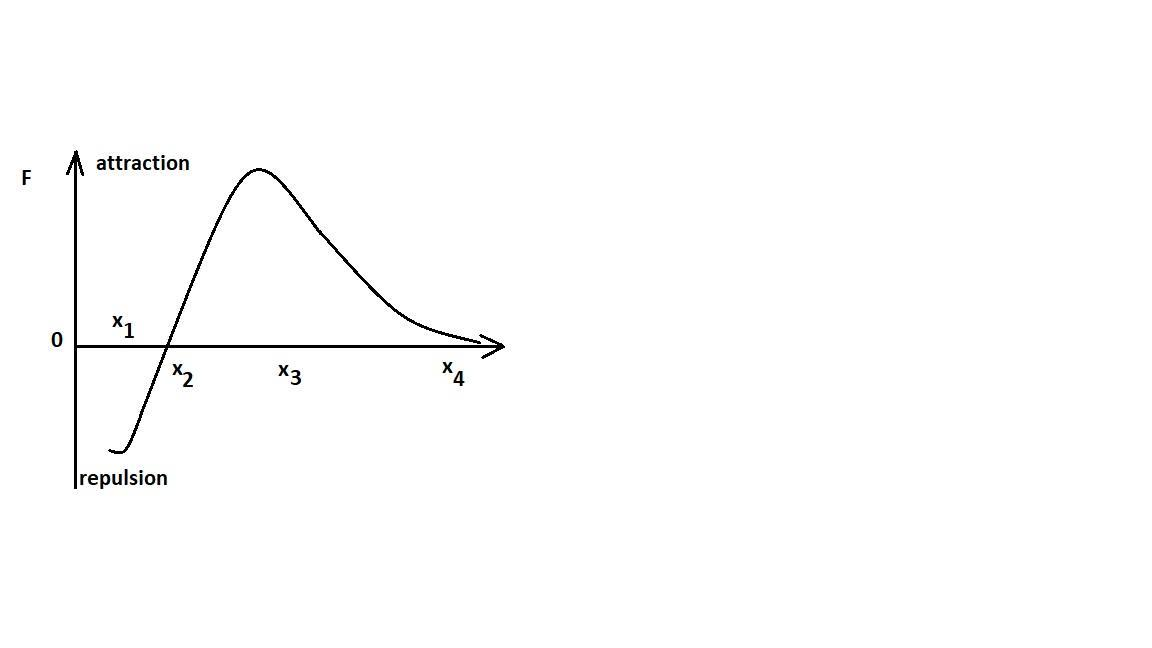
The diagram given shows how the net interaction force (conservative) between two particles $A$ and $B$ is related to the distance between them varies from \[{x_1}\] to \[{x_2}\] . Then
(A) Potential energy of the system increases from \[{x_1}\] to \[{x_2}\]
(B) Potential energy of the system increases from \[{x_2}\] to \[{x_3}\]
(C) Potential energy of the system increases from \[{x_3}\] to \[{x_4}\]
(D) KE increases from \[{x_1}\] to \[{x_2}\] and decreases from \[{x_2}\] to \[{x_3}\]

Answer
143.1k+ views
Hint: We will pull in the concept of potential energy to be the work done stored by the system. We will then try out the relationships and then finally find the correct option.
Formulae Used $F = - \frac{{dU}}{{dx}}$
Step By Step Solution
Firstly,
$F = - \frac{{dU}}{{dx}}$
Thus, we can say,
\[dU = - Fdx\]
Now,
Clearly,
When $F$ is positive, $dU$ is negative and when $F$ is negative, $dU$ is positive.
For the region from \[{x_1}\] to \[{x_2}\] , $F$ is negative as we can see from the graph itself.
Thus, $dU$ is positive.
Which means potential energy increases from \[{x_1}\] to \[{x_2}\].
Now,
Again for the region \[{x_2}\] to \[{x_3}\], $F$ is positive.
Thus, we can say $dU$ is negative.
Which means that potential energy decreases from \[{x_2}\] to \[{x_3}\].
Now,
For the region \[{x_3}\] to \[{x_4}\] , the force keeps on decreasing making it negative.
Thus,
$F$ is negative here.
Thus,
\[dU\] is positive.
Which means potential energy increases here.
Thus, taking all these observations into consideration, we can say (A) is the correct option.
Note: When $dU$ is positive, the potential energy increases because $dU$ refers to the change in the potential energy. When its value is positive, the final potential energy value is greater than the initial potential energy value. Thus making its overall value to be positive. The same analogy goes true when $dU$ is negative.
Formulae Used $F = - \frac{{dU}}{{dx}}$
Step By Step Solution
Firstly,
$F = - \frac{{dU}}{{dx}}$
Thus, we can say,
\[dU = - Fdx\]
Now,
Clearly,
When $F$ is positive, $dU$ is negative and when $F$ is negative, $dU$ is positive.
For the region from \[{x_1}\] to \[{x_2}\] , $F$ is negative as we can see from the graph itself.
Thus, $dU$ is positive.
Which means potential energy increases from \[{x_1}\] to \[{x_2}\].
Now,
Again for the region \[{x_2}\] to \[{x_3}\], $F$ is positive.
Thus, we can say $dU$ is negative.
Which means that potential energy decreases from \[{x_2}\] to \[{x_3}\].
Now,
For the region \[{x_3}\] to \[{x_4}\] , the force keeps on decreasing making it negative.
Thus,
$F$ is negative here.
Thus,
\[dU\] is positive.
Which means potential energy increases here.
Thus, taking all these observations into consideration, we can say (A) is the correct option.
Note: When $dU$ is positive, the potential energy increases because $dU$ refers to the change in the potential energy. When its value is positive, the final potential energy value is greater than the initial potential energy value. Thus making its overall value to be positive. The same analogy goes true when $dU$ is negative.
Recently Updated Pages
How to find Oxidation Number - Important Concepts for JEE

How Electromagnetic Waves are Formed - Important Concepts for JEE

Electrical Resistance - Important Concepts and Tips for JEE

Average Atomic Mass - Important Concepts and Tips for JEE

Chemical Equation - Important Concepts and Tips for JEE

Concept of CP and CV of Gas - Important Concepts and Tips for JEE

Trending doubts
JEE Main 2025 Session 2: Application Form (Out), Exam Dates (Released), Eligibility, & More

JEE Main Exam Marking Scheme: Detailed Breakdown of Marks and Negative Marking

JEE Main 2025: Derivation of Equation of Trajectory in Physics

Electric Field Due to Uniformly Charged Ring for JEE Main 2025 - Formula and Derivation

Degree of Dissociation and Its Formula With Solved Example for JEE

Physics Average Value and RMS Value JEE Main 2025

Other Pages
Units and Measurements Class 11 Notes: CBSE Physics Chapter 1

JEE Advanced Marks vs Ranks 2025: Understanding Category-wise Qualifying Marks and Previous Year Cut-offs

NCERT Solutions for Class 11 Physics Chapter 1 Units and Measurements

JEE Advanced 2025: Dates, Registration, Syllabus, Eligibility Criteria and More

Motion in a Straight Line Class 11 Notes: CBSE Physics Chapter 2

JEE Advanced Weightage 2025 Chapter-Wise for Physics, Maths and Chemistry




